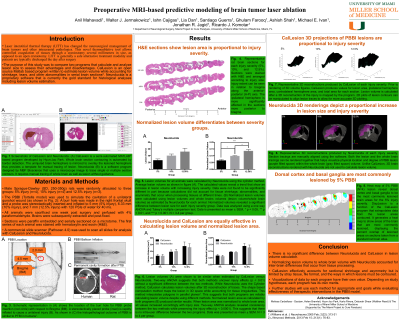Motor deficit amelioration in rats with penetrating traumatic brain injury (pTBI) is injury-transplantation interval dependent
Motor Deficit Amelioration in Rats with Penetrating Traumatic Brain Injury (pTBI) Is Injury-transplantation Interval Dependent
Friday, April 21, 2023

- AM
Anil Mahavadi, MD
Resident Physician
University of Alabama Birmingham
Birmingham, Alabama, United States
ePoster Presenter(s)
Introduction: Penetrating traumatic brain injury (PTBI) induced severe disability remains a challenge due to a lack of endogenous reparative neurogenesis and neuroprotective therapies. Acute and chronic TBI benefits from human neural stem cells (hNSCs) therapy, but the transplantation therapeutic window is unknown. The objective of this study is to determine whether motor recovery is associated with the interval between injury and hNSC transplantation.
Methods: Sprague Dawley rats were randomized into three pairs of experimental groups of 10 animals each. Each pair had animals with either sham or penetrating TBI (pTBI) injuries. All paired groups were transplanted with 0.5 million hNSCs perilesionally at one of the following three time points after injury: one week post-injury: Groups 1 & 2 (Sham-Transplant & pTBI-Transplant), two weeks: Groups 3 & 4 (Sham-Transplant & pTBI-Transplant), four weeks: Groups 5 & 6 (Sham-Transplant & pTBI-Transplant). All animals were allowed to survive twelve weeks with standard immunosuppression. Motor outcomes assessed one-week post-pTBI (to establish pre-transplant deficit), eight weeks, and twelve weeks post-transplantation (to assess therapeutic effect) using the grid-walk test followed by perfusion and histology.
Results: The foot-fault rate for Group 1, Group 3, Group 5 were not statistically different, but compared to pre-transplant injury baseline, strong injury effect observed (p < 0.0001). Foot-fault rates within injury + transplant groups appeared to increase with interval to transplant. Compared to the pre-transplant injury baseline, a significant difference was found at Group 2 (p = 0.0466), but not other intervals (p = 0.2131) and (p = 0.5956) for Group 4 and Group 6, respectively.
Conclusion : Although engraftment is independent of injury-transplant interval, the enduring motor deficit was mitigated only in the group with the shortest interval to transplantation which coincided with reduced secondary injury progression. While encouraging, additional experiments with longer duration are required to uncover full cell replacements effects.
Methods: Sprague Dawley rats were randomized into three pairs of experimental groups of 10 animals each. Each pair had animals with either sham or penetrating TBI (pTBI) injuries. All paired groups were transplanted with 0.5 million hNSCs perilesionally at one of the following three time points after injury: one week post-injury: Groups 1 & 2 (Sham-Transplant & pTBI-Transplant), two weeks: Groups 3 & 4 (Sham-Transplant & pTBI-Transplant), four weeks: Groups 5 & 6 (Sham-Transplant & pTBI-Transplant). All animals were allowed to survive twelve weeks with standard immunosuppression. Motor outcomes assessed one-week post-pTBI (to establish pre-transplant deficit), eight weeks, and twelve weeks post-transplantation (to assess therapeutic effect) using the grid-walk test followed by perfusion and histology.
Results: The foot-fault rate for Group 1, Group 3, Group 5 were not statistically different, but compared to pre-transplant injury baseline, strong injury effect observed (p < 0.0001). Foot-fault rates within injury + transplant groups appeared to increase with interval to transplant. Compared to the pre-transplant injury baseline, a significant difference was found at Group 2 (p = 0.0466), but not other intervals (p = 0.2131) and (p = 0.5956) for Group 4 and Group 6, respectively.
Conclusion : Although engraftment is independent of injury-transplant interval, the enduring motor deficit was mitigated only in the group with the shortest interval to transplantation which coincided with reduced secondary injury progression. While encouraging, additional experiments with longer duration are required to uncover full cell replacements effects.
